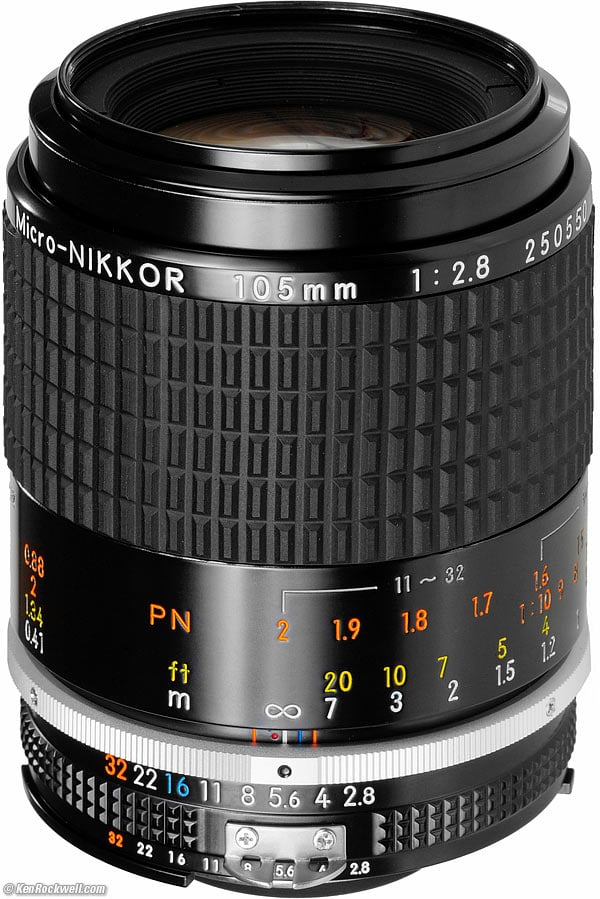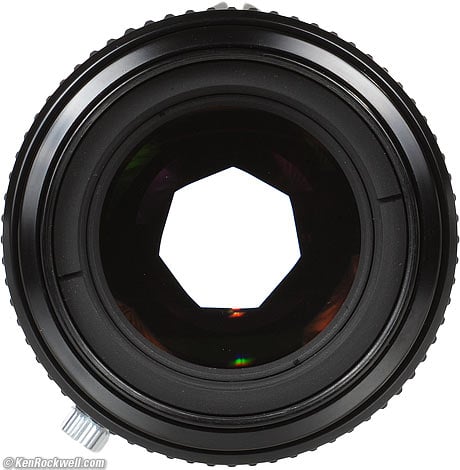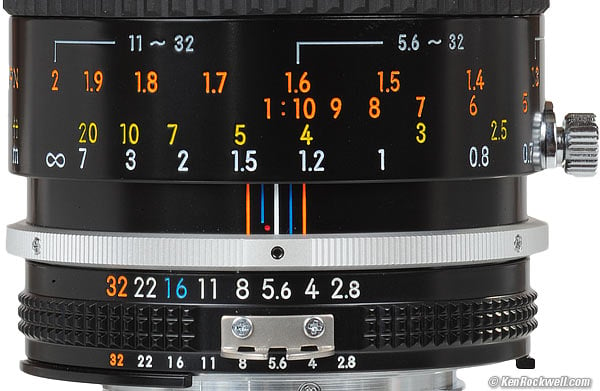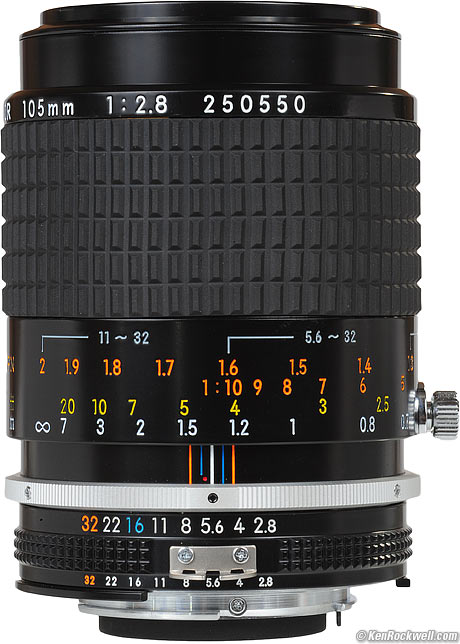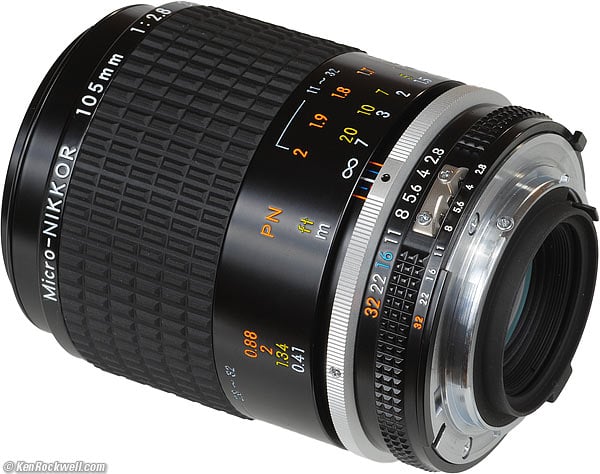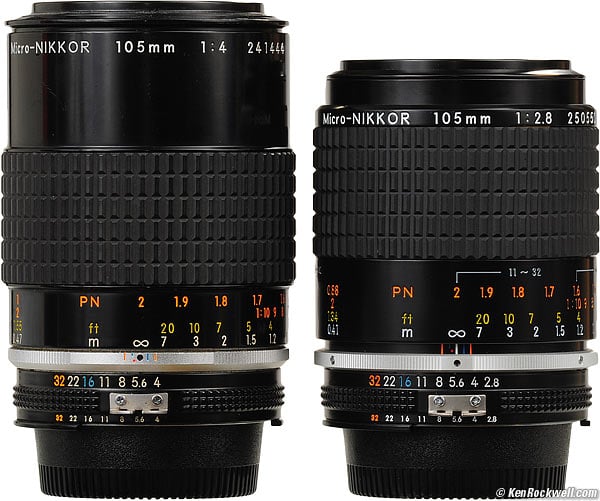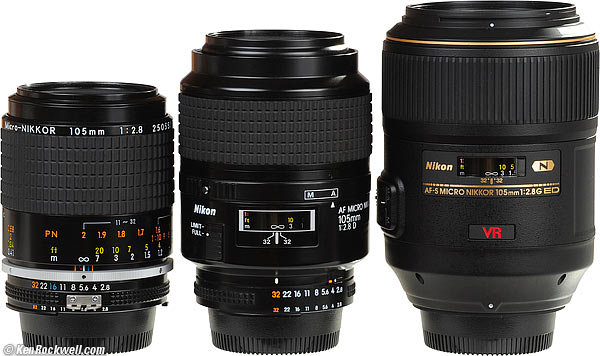Home Donate New Search Gallery Reviews How-To Books Links Workshops About Contact
Nikon 105mm f/2.8
Micro-NIKKOR (Macro, 1983-2021)
© 2010-2013 KenRockwell.com. All rights reserved.
How to Shoot Macro Best Macro Lenses Compared
Intro Specifications Performance Compared Recommendations
Nikon 105mm f/2.8 AI-s (FX, DX and 35mm coverage, 52mm filters, 18.0 oz./510g, about $175 used). enlarge. I got mine at this direct link to them at eBay (see How to Win at eBay).
My biggest source of support for this free website is when you use those or any of these links when you get anything, regardless of the country in which you live — but I receive nothing for my efforts if you buy elsewhere. I'm not NPR; I get no government hand-outs and run no pledge drives to support my research, so please always use any of these links for the best prices and service whenever you get anything. Thanks for helping me help you! Ken.
Ideal Uses
General-purpose manual-focus tele and macro for FX and film.
Manual focus, color Matrix-metered auto exposure and viewing are perfect with all FX DSLRs.
Not for
As a manual-focus lens, I wouldn't use it for sports, kids or action since it's too hard to track focus by hand.
| Optics: | |
| Ergonomics: | |
| Usefulness: | |
| Availability: | |
| Overall: |
June 2013 Nikon Reviews Nikon Lenses All Reviews
105mm f/2.8 VR (2007-today)
105mm f/2.8 AF (1990-2007)
105mm f/4 AI (1980-1983)
Nikon 105mm Center Sharpness Comparison
Nikon 105mm Corner Sharpness Comparison
Why fixed lenses take better pictures.
Introduction top
Intro Specifications Performance Compared Recommendations
The manual-focus Nikon Micro-NIKKOR 105mm f/2.8 has excellent optics and mechanics. It is at least 90% as good as today's newest 105mm lenses wide-open, and at least as good stopped down. Unlike the newest lenses, it is manual-focus only, which is ideal for macro work.
"Micro" is Nikon's word for Macro. I will use these words interchangeably.
This f/2.8 lens was introduced in 1983 to replace the slower 105mm f/4 Micro-NIKKOR AI-s. The faster speed makes focusing at macro distances easier on manual-focus cameras, although it's not that big a deal on today's FX DSLRs.
This manual-focus lens works splendidly on all Nikon FX digital cameras.
On the D3X, D3S, D3, D700, D300, D200, D2 and F6, use the "Non-CPU Lens Data" menu option to set 105mm and f/2.8 to get full matrix metering, EXIF data and finder read-out of set aperture. It works great in aperture-preferred as well as manual modes on these cameras.
The manual-focus Nikon 105mm f/2.8 AI-s works flawlessly with every manual focus Nikon ever made, from the F of 1959 through the FM3a and today's FM-10.
This lens works perfectly on every professional film camera (F, F2, F3, F4, F5, F6), and adds Matrix metering on the FA, F4 and F6.
The meters of cheaper digital (D90, D5000 and below) and cheaper film cameras (N80 and below) will not couple (or work at all) with this lens, so you'll be on your own guessing exposure using the rear LCD or an external meter, or get a tiny Gossen Digisix meter and hot shoe adapter to meter manually.
See Nikon Lens Compatibility for details on your camera. Read down the "AI, AI-s" column for this lens.
Price, new* |
Corrected for inflation, 2010 |
2022 |
|
1986 |
$310 |
$615 |
|
1987 |
$400 |
$775 |
|
1988 |
$550 |
$1,000 |
|
1991 |
$490 |
$785 |
|
1992 |
$500 |
$775 |
|
1994 |
$600 |
$885 |
|
1995 |
$660 |
$945 |
|
1996 |
$590 |
$820 |
|
1997 |
$590 |
$800 |
|
1998 |
$500 |
$670 |
|
1999 |
$600 |
$785 |
|
2000 |
$575 |
$730 |
|
2010 |
$775, catalog |
||
2013 |
$775, catalog |
||
2022 |
|
* At full NYC discount. Very few people bought their lenses this inexpensively back then.
Specifications with commentary top
Intro Specifications Performance Compared Recommendations
Name
Nikon calls this the Nikon Micro-NIKKOR 105mm f/2.8 AI-s.
Optics top
Nikon 105mm f/2.8 AI-s. enlarge.
10 elements in 9 groups.
Multicoated.
Nikon calls the floating element system "CRC," for close-range correction. This means this lens optimizes its design for perfect performance as you focus at any distance.
The only problem is that if you use extension tubes or a bellows, that the corrections become progressively worse as the focus ring is turned towards infinity. Therefore one needs to stop-down for decent results with extenders. This is why there are suggested aperture ranges engraved in gray on the focus scale.
Diaphragm top
Nikon 105mm f/2.8 AI-s at f/5.6. (Note focus drag screw.) enlarge.
7 straight blades.
Stops down to f/32.
Full-stop clicks.
Aperture Ring top
Yes, metal.
Full-stop clicks.
Close Focus top
1.34 feet.
0.41 meters.
Working Distance top
9.5" (240mm), measured at 1:2.
(The working distance for the 105mm f/4 is 11" or 280mm)
Maximum Reproduction Ratio top
1:2.
With the PN-11 extension tube, 1:0.88 (1.14x life-size).
PN-11 Auto Extension Tube top
52.5mm flange-to-flange length.
2.8" (70.5mm) diameter by 2.7" (67mm) overall length.
Rated 8.6 oz. (245g).
Nikon part number 2647.
Takes BF-1A body cap and LF-1 rear cap.
Optional #61 pouch.
Focus Lock top
Yes.
A small chrome set screw on the focus scale at about the 2 feet (0.6m) position allows one to increase focus drag to prevent accidental knocking in laboratory setups.
It doesn't actually "lock" the focus; it merely makes it stick harder so it's less likely to get knocked.
Hard Infinity Focus Stop? top
Yes.
This is great for astronomy; just turn to the stop and you have fixed laboratory-perfect focus all night.
Focus Scale top
Yes, detailed.
Depth-of-Field Scale top
Yes, but limited.
Infra-Red Focus Index top
Yes: red dot in depth-of-field scale.
Filter Thread top
52mm, metal.
Does not rotate.
Optional AF-1 gelatine filter holder.
Tripod Collar top
None on lens.
Rotating tripod collar on optional PN-11 extension ring with 90º click stops and locking screw.
Size top
Nikon specifies 3.3" (83.5mm) extension from flange (3.6" or 91.5mm overall length) by 2.36" (66.5mm) diameter.
Weight top
17.972 oz. (509.55g), measured.
Nikon specifies 18.2 oz. (515g).
Hood top
HS-14, included.
Case top
CL-33S hard case, optional.
CP-9 plastic bubble, optional.
Pouch No. 62, optional.
Pouch No. 63 for use with attached PN-11, optional.
Made in top
Japan.
Teleconverters top
Nikon suggests the TC-200 and TC-201 (2x), and the TC-14A (1.4x).
Nikon Product Number top
1455.
Price top
See Pricing, above.
Performance top
Intro Specifications Performance Compared Recommendations
Overall Focus Bellows and Rings Bokeh Color
Distortion Ergonomics Exposure Compensation Falloff
Filters Flare & Ghosts Color Fringes Mechanics
Sharpness Spherochromatism Sunstars
Overall performance top
The 105mm f/2.8 AI-s is a superb lens, both optically and mechanically. Which would you prefer: today's half-plastic, $900 made-in-China 105mm f/2.8 VR with its crappy plastic bayonet hood, or this all-metal, superbly focusing compact 105mm Micro for about $150 used?
Focus performance top
Manual focus is perfect.
Focus is smooth and perfectly damped with no play.
It offers high precision; it takes about 300º to go from infinity to 1:2.
There is a focus lock screw on the focus ring. It doesn't really "lock" as much as it allows the addition of a little more drag so that focus won't get knocked in laboratory settings.
The D3, D3X, D3s, D700, F4, F5, F6 and most professional AF cameras have three very precise electronic manual focus indicators, with which this lens works perfectly.
Lesser digital cameras, like the D300 and down, usually have just one "OK" focus dot, which is not as precise as two arrows and a dot.
Focus is perfect with today's digital FX cameras as well as older manual focus cameras.
Bellows, PN Rings and Ultra-Closeups top
This f/2.8 lens works great with bellows and close-up extension tubes like the PN-11.
Because the 105mm f/2.8 uses floating elements for close-range-correction (CRC), the optics are always optimum for use at any magnification — so long as you're in the range from infinity to 1:2 (1.34 feet or 0.41m).
As soon as you put anything between this lens and your camera, the focus ring will be in a position which does not represent the actual distance, which means that the optics will not be correctly optimized. Because of this new optical flaw, you should stop-down the lens from f/2.8 to ensure the best performance.
If the lens barrel is set to infinity, the optics will be least optimum for close-up work, and if set to 1.34 feet (0.41m), they will be optimum for close-up work.
Therefore, strive to set the lens to its closest distance when on the PN-11 ring or on bellows.
Focus Scale, Nikon 105mm f/2.8 AI-s Micro-NIKKOR. enlarge.
See the gray bands marked with apertures? These are suggested aperture ranges to use when on the PN-11 ring. In other words, try to stop down to at least f/11 while on the PN-11 ring when the focus ring is set to 1:2 through 1:1.6, and by 1:1.6, it's OK to open up as far as f/5.6. By 1:1.3 it's OK to use f/4, and at 1:1 and bigger it's OK again to use f/2.8.
If this drives you crazy, the Nikon 105mm f/4 Micro-NIKKOR (1970-1983) uses fixed optics, and may be used wide-open at any magnification.
Bokeh performance top
Bokeh is the character of out of focus areas, not simply how far out of focus they are.
Bokeh is excellent at all distances. If you have specular highlights, the circles are very neutral and you will see the septagonal diaphragm.
Here are two snaps of a bush at about 5 meters (15 feet), with the lens focused at about 0.6 meters (two feet). These are full-frame images from a D3.
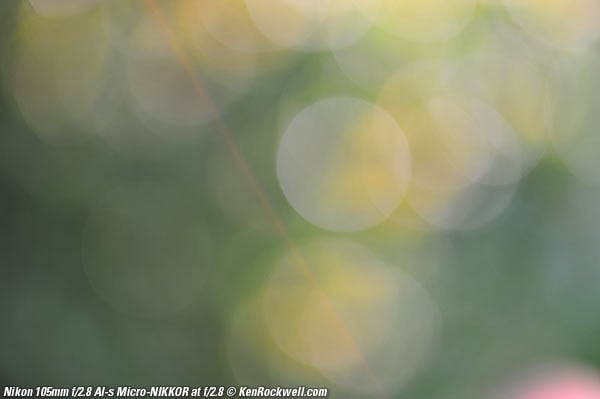
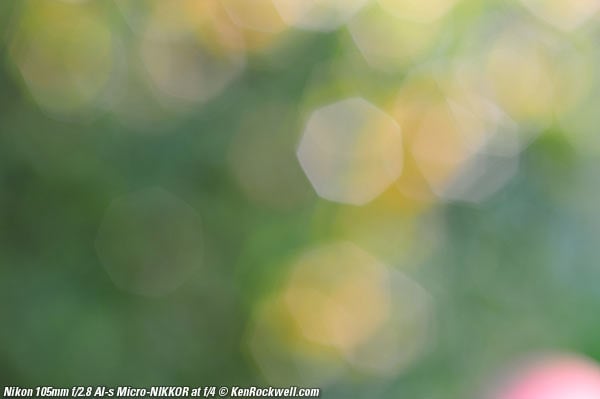
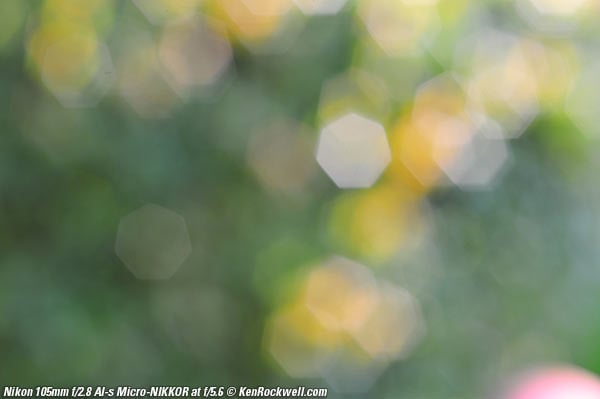
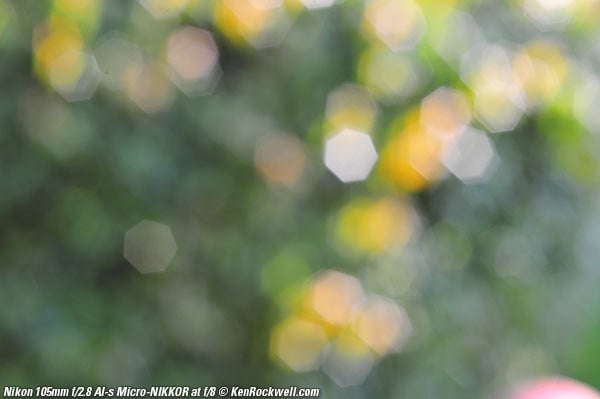
Color Rendition performance top
Nikon 105mm f/2.8 AI-s at f/11. enlarge.
The color rendition of this multicoated Nikon 105/2.8 AI-s seems the same as all of my other multicoated NIKKORs.
Distortion performance top
The Nikon 105mm f/2.8 has no visible distortion at any distance.
I wouldn't even bother with these figures into Photoshop CS2's lens distortion filter, because at least through version CS4, Photoshop itself lacks the precision to use values this low!
FX and Film |
||
∞ |
-0.1 |
0.0 |
10' (3m) |
0.0 |
|
1:4 |
0.0 |
|
1:2 |
-0.1 |
© 2010 KenRockwell.com. All rights reserved.
Ergonomics performance top
Nikon 105mm f/2.8 AI-s. enlarge.
The Nikon 105mm f/2.8's ergonomics are great.
Focus is easy, and the aperture ring works as on all real NIKKOR lenses.
Exposure Compensation performance top
Macro lenses get darker as focused more closely. To keep it simple, as the lens increases its magnification at close distances, the light gets spread more thinly.
There is never any need to compensate on most cameras, both with regular and flash metering, because they meter the light that actually makes it through the lens (TTL).
If you are unusual and using an external light or flash meter, you will need to open the aperture a bit to compensate for the loss of light at macro distances, in order to get the actual aperture you think you're setting.
There is an exposure compensation table in your instruction book with the factors needed, but they are only needed with external meters. Ignore this otherwise.
Falloff (darkened corners) performance top
The Nikon 105mm f/2.8 no visible falloff on FX, unless you shoot the same thing on a tripod and flick between the same image shot at f/2.8 and other apertures, in which case you can see a slight differences between the images. Looking at just one photograph shot at f/2.8, the falloff isn't visible by itself; it's only visible in direct comparison to other apertures.
It's gone by f/4 in any case.
It doesn't vary with magnification.
I've exaggerated this by shooting a gray field and placing these on a gray background. By comparison, today's 105mm VR has more falloff.
Nikon 105mm f/2.8 AI-s falloff on FX and film, no correction.
© 2010 KenRockwell.com. All rights reserved.
|
Filters, Use with performance top
Like most long lenses, there is no problem with vignetting, even with combinations of a couple of stacked thick filters.
Flare and Ghosts performance top
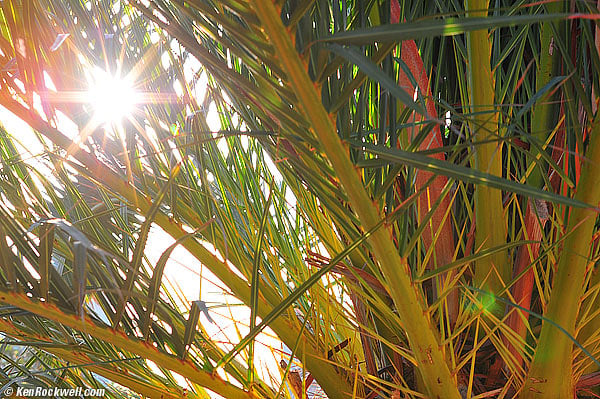
Nikon 105mm f/2.8 AI-s at f/11, pointed directly at the Sun.
The complex design of the 105mm f/2.8 AI-s (10 elements in 9 groups) leads itself to more problems with ghosts and flare than the very simple 105mm f/4 Micro-NIKKOR (5 elements in 3 groups). This f/2.8 lens has 18 air-to-glass surfaces, while the f/4 lens has only six.
Ghosts are invisible under any sane use, but unlike the 105/4, if you 1.) point it directly at the blinding California sun, 2.) overexpose (this snap is at +1.7 stops compensation), and 3.) deliberately put something dark where ghosts might fall, this example is as bad as I can make it look.
I doubt one would ever see this in real use, but if it bothers you, get the equally high-performance 105mm f/4 instead.
Hint: if you can't see the ghost above, it's the green blob on the lower right.
Lateral Color Fringes performance top
There are no lateral color fringes on the D3X or D3, which would correct them if the lens had any.
Used with an adaptor on a Canon 5D Mark II, there are just the slightest, which is a little better than Canon's own $1,000 100mm f/2.8L IS Macro!
Mechanics performance top
Nikon 105mm f/2.8 AI-s. enlarge.
Like all Nikkor manual focus AI-s lenses, the Nikon NIKKOR 105mm f/2.8 AI-s is built to the highest mechanical standards of any lens ever made.
Barrel Exterior
Anodized and enameled aluminum.
Filter Threads
Anodized aluminum.
Focus Ring
Metal, rubber covered.
Focus Helicoids
Feels like brass.
Depth-of-Field Scale
Engraved into silver grip ring and filled with different colors of paint.
Internals
All metal.
Aperture Ring
Cast aluminum, anodized and enameled.
Engraved markings filled with different colors of paint coded to the depth-of-field scale.
Mount
Dull-chromed brass.
Markings
Engraved into the metal and filled with paint.
Identity and Serial Number
Engraved into the metal focus ring and filled with paint.
Ass-Gasket (dust seal at mount)
No.
Noises When Shaken
Mild clicking from the diaphragm blades and actuation system.
Made in
Japan.
Sharpness performance top
Warning 1: Image sharpness depends more on you than your lens.
Warning 2: Lens sharpness doesn't mean much to good photographers.
Warning 3: Lens sharpness especially doesn't matter with macro lenses, since sharpness in macro ranges depends more on our ability to manage planes of focus and depth-of-field than any limitation of the lens' optics. Serious macro shooting is done at f/32, where diffraction makes all lenses equal anyway.
With these caveats, this 105mm f/2.8 AI-s is as ridiculously sharp as you'd expect from a macro lens.
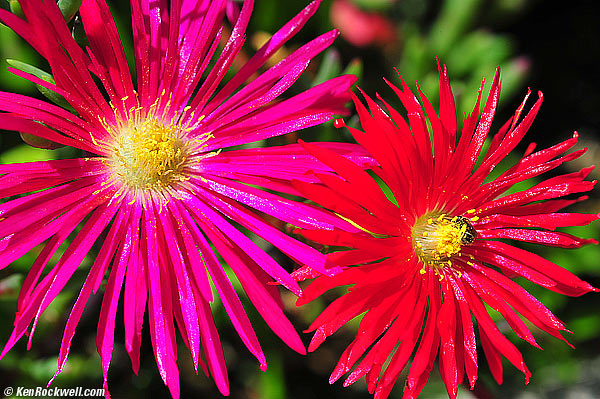
Nikon 105mm f/2.8 AI-s at f/11 on a 12MP D3.
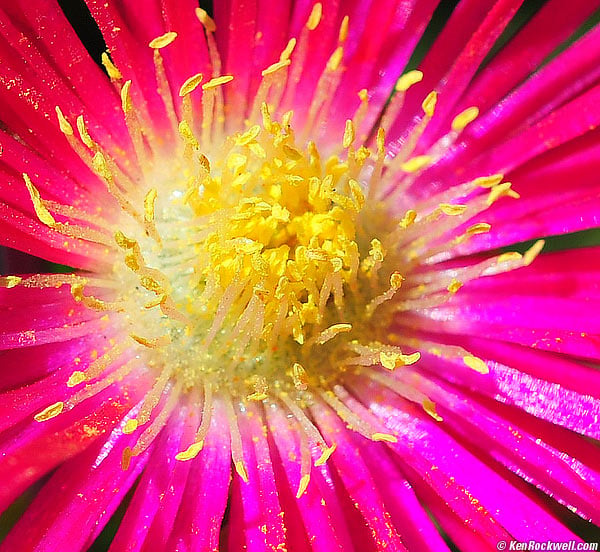
Crop from above.
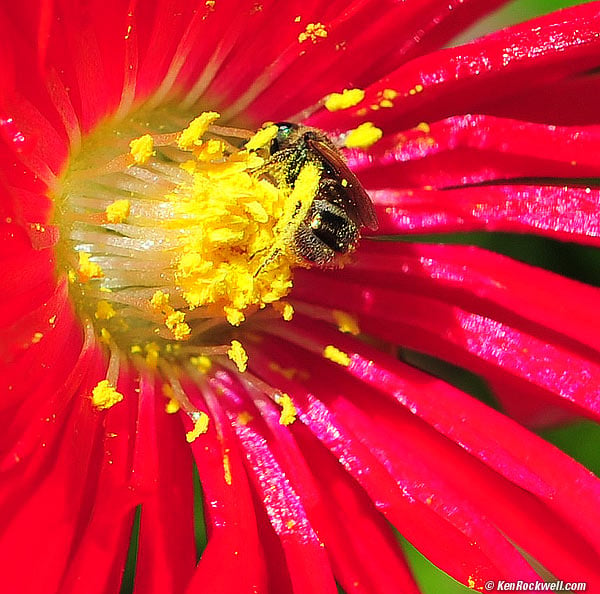
Crop from the other flower above. Aha!
The snaps above are hand-held at 1/250 on a 12MP D3. The 105/2.8 AI-s is much sharper than 12MP can show, especially since very little, if any of this, is actually in perfect focus, and it's all moving.
See also Nikon 105mm Center Sharpness Comparison
and Nikon 105mm Corner Sharpness Comparison.
As shot on a 24MP full-frame D3X at infinity
At f/2.8
Sharp in the center, and a little softer on the sides.
At f/4
The sides perk up, but are still slightly less sharp than the ultra sharp center.
At f/5.6
The sides are even better than they were at f/4.
At f/8
The center is very, very slightly less sharp due to diffraction, however the sides are optimum.
f/8 is the optimum aperture for this lens at infinity.
At f/11 and smaller
Diffraction limits performance more than the optics themselves.
As shot on a 12MP full-frame D3 or D700 at infinity
I see the same thing on the 12MP cameras, just that the very slight softening on the sides is less obvious. 12MP cameras aren't as picky about optics as the 24MP FX cameras.
Spherochromatism performance top
The Nikon 105mm f/2.8 has some slight spherochromatism, meaning that out-of-focus highlights can sometimes take on a little bit of green or magenta color fringes.
If you see it, background highlights might take on slight green fringes, and nearer out-of-focus highlights might take on slight magenta fringes.
Sunstars performance top

Nikon 105mm f/2.8 AI-s at f/11, pointed directly at the Sun.
With its straight 7-bladed diaphragm, the 105mm f/2.8 makes somewhat asymmetrical 14-pointed sunstars on bright points of light.
Oddly, it sometimes shows only 7 points, or seven of them may be stronger than the other 7 points.
Compared top
Intro Specifications Performance Compared Recommendations
Nikon 105mm Center Sharpness Comparison
Nikon 105mm Corner Sharpness Comparison
See also History of the 105mm Micro
Nikon 105mm f/4 AI-s and f/2.8 AI-s. enlarge.
Nikon 105mm f/2.8 AI-s, f/2.8 AF-D and f/2.8 VR G. enlarge.
Sharpness on the Nikon D3X
In test conditions, as shot on a 24MP Nikon D3X at f/4 and infinity, this f/2.8 lens is about as sharp as the Nikon 105mm f/4 AI-s (1970-1983), but not as sharp as the Nikon 105mm f/2.8 AF (1990-2007). At f/2.8, the AF lens is sharper - but only on the sides.
As shot on a 24MP Nikon D3X at f/8 and infinity, all three are equally excellent.
Sharpness on the Canon 5D Mark II
On a 21MP Canon 5D Mark II with an adaptor, which doesn't correct lateral color fringes as do Nikon cameras, I did a direct comparison between the 105mm f/4 (1970-1983), Canon's newest 100mm f/2.8 IS L lens (2009-today), this 105mm f/2.8 AI-s (1983-today) and the 105mm f/2.8 AF (1990-2007) lenses.
At f/2.8 and infinity this manual-focus Nikon is much better than the $1,000 Canon, on Canon's own 5D Mark II!
A f/8 on the 5D Mark II at infinity, this Nikon lens and the Canon 100mm f/2.8 IS L are equally sharp, however this NIKKOR has less lateral color fringing.
This f/2.8 lens was the best of all the tested macros — on the 5D Mark II, which doesn't correlate to performance on Nikon bodies, on which I found the 105mm f/2.8 AF to be the sharpest.
Comparison Table
105/2.8 AI-s |
||||||
| Anno | 1970-1983 |
1983-today |
1990-2007 |
2006-today |
2000-2009 |
2009-today |
| Filter | 52mm |
52mm |
52mm |
62mm |
58mm |
67mm |
| Filter | Metal |
Metal |
Metal |
plastic |
plastic |
plastic |
| Length | 96mm |
83.5mm |
104.5mm |
116mm |
118.2mm |
123mm |
| Barrel | Metal |
Metal |
Plastic and metal |
Plastic and metal |
plastic |
plastic |
| Weight, g. | 500g |
510g |
562g |
752g |
584g |
623g |
| Weight, oz. | 17.6 oz. |
18.0 oz. |
19.8 oz. |
26.6 oz. |
20.6 oz. |
22.0 oz. |
| Optics | Ex |
Ex |
Ex |
Ex |
Ex |
Ex |
| Working Distance | 11" |
9.5" |
5.2" |
6" |
6" |
5.2" |
| Working Distance | 280mm |
240mm |
133mm |
154mm |
150mm |
133mm |
| Maximum Repro | 1:2 |
1:2 |
1:1 |
1:1 |
1:1 |
1:1 |
| Manual Focus | Always |
Always |
Must move switch |
Instant override |
Instant override |
Instant override |
| Ergonomics | Ex |
Ex |
OK |
Ex |
Ex |
Ex |
| Price, 7/2010 USA | $125 used |
$150 |
$350 Used |
To get used prices this good, see How to Win at eBay.
Recommendations top
Intro Specifications Performance Compared Recommendations
This modern classic 105mm f/2.8 Micro-NIKKOR AI-s works splendidly on today's newest digital FX cameras. Vibration Reduction and Autofocus of newer versions is very helpful for general photography, but they are mostly irrelevant for macro use.
If you want a great 105mm Macro, both this and the 105mm f/4 are excellent choices at any price, and when you get them used, a bargain.
For use on FX cameras like the D3X, D3S, D3 and D700, the 105mm f/2.8 AF-D might be more practical for general use because it's autofocus, but it still costs twice as much, used.
Why would anyone want to pay $890 for the plasticy, made-in-China Nikon 105/2.8 VR? It has more light falloff, it weighs more, it's bigger and longer, and it's gelded (G) to prevent its use on older cameras. The only reason I can fathom is for people with lots of money to burn, and who intend to use it for general photography, where VR and autofocus are very handy.
For serious 105mm macro use, this 105mm f/2.8 Micro-NIKKOR is superb. However, for really serious macro use I prefer 200mm lenses because they give me enough room away from my subject and a more pleasing perspective. All the product photos you see on most of my pages, especially this one, are shot with Nikon's 200mm AF-D Micro for exactly these reasons.
I don't suggest Nikon's inexpensive (about $350 used) manual-focus 200mm f/4 AI-s Micro-NIKKOR (1978-2005) for digital macro work because it has a lot of lateral color fringes at close range.
The Nikon 105mm f/2.8 AI-s is a manual-focus only lens, which is an advantage for macro use, since its manual-focus ring is much more pleasant than the AF lens' manual focus rings.
Deployment top
I'd leave either a 52mm Nikon Clear (NC - UV) filter, or a 52mm Hoya Super HMC UV on the lens at all times.
If yours is an older one with Nikon's flat front cap, I'd chuck it and get a new "pinch" type cap in 52mm. I'm not kidding: the new fatter caps are much easier to use in the field.
If I was working in nasty, dirty areas, I'd forget the cap, and use an uncoated 52mm Tiffen UV filter instead. Uncoated filters are much easier to clean, but more prone to ghosting.
Help me help you top
I support my growing family through this website, as crazy as it might seem.
The biggest help is when you use any of these links when you get anything, regardless of the country in which you live. It costs you nothing, and is this site's, and thus my family's, biggest source of support. These places have the best prices and service, which is why I've used them since before this website existed. I recommend them all personally.
If you find this page as helpful as a book you might have had to buy or a workshop you may have had to take, feel free to help me continue helping everyone.
If you've gotten your gear through one of my links or helped otherwise, you're family. It's great people like you who allow me to keep adding to this site full-time. Thanks!
If you haven't helped yet, please do, and consider helping me with a gift of $5.00.
As this page is copyrighted and formally registered, it is unlawful to make copies, especially in the form of printouts for personal use. If you wish to make a printout for personal use, you are granted one-time permission only if you PayPal me $5.00 per printout or part thereof. Thank you!
Thanks for reading!
Mr. & Mrs. Ken Rockwell, Ryan and Katie.
Home Donate New Search Gallery Reviews How-To Books Links Workshops About Contact

